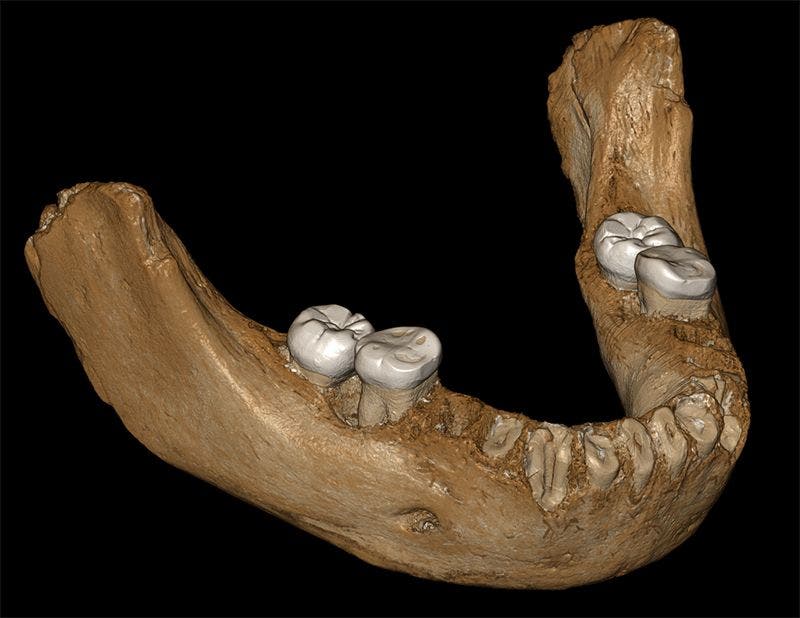When the first Denisovan fossil was found in 2010, it was hailed as a stunning discovery. Here was another species related to humans, clearly distinct from the Neanderthals and Homo sapiens. However, fossil evidence of this species had only been found in the Denisova Cave in Siberia, from which the Denisovans were named.
Now, a new fossil discovered in Tibet shows that the Denisovans weren’t nearly as localized as some thought. They spread far and wide, being capable of living at impressive altitudes.

High Denisovans
Back in 1980, a Tibetan monk found a rather unusual fossil: a seemingly human jawbone. The monk passed it on to Lanzhou University, but the fragment was ignored until the 2010s when archaeologist Dongju Zhang and her colleagues began studying the bone. A recent study has now confirmed that the jawbone belonged to a Denisovan, a group of humanoids that lived alongside humans and Neanderthals, interbreeding with them several times across history.
Although genetic analysis has shown that the Denisovans were a unique group, remains from them have been sparse, and until now, limited only to the Denisova Cave. Of course, it’s not plausible that a humanoid group inhabited a single cave, so the hunt was on for other fossils. Jean-Jacques Hublin of the Max Planck Institute for Evolutionary Anthropology in Leipzig, Germany, wondered if they could find such remains in the Tibetan plateau, and turned to the jawbone from Lanzhou University.
Denisovans split from humans about 550,00–765,000 years ago, but we still carry some of their genetic legacies. Previous studies have suggested that Denisovans were well adapted to living in cold environments and at high altitudes, but the fact that they could survive in Tibet is remarkable.
The altitude of the new Denisovan’s home is 3,280 meters ( 10,700 feet) above sea level, an altitude at which you need special adaptations to be able to survive. This also changes the anthropological history of Tibet and the Himalayas, as previous research claimed that the area was first populated by humans around 40,000 years ago. This new finding pushes that date back by 100,000 years.

It’s not completely surprising, however — actually, this finding might help solve one pressing riddle about the genetic history of the Tibetan people: Tibetans and other populations in the region have a gene inherited from Denisovans that helps them live at high altitudes, but how they got this gene from the Denisovans in the first place is a mystery. The fact that Denisovans developed it in the first place was just as puzzling, considering that their only remains had been found in a low-lying area.
“Frankly speaking, until today, nobody ever imagined that archaic humans could be able to dwell in such an environment,” said Jean-Jacques Hublin, a co-author and paleoanthropologist at the Max Planck Institute for Evolutionary Anthropology. “It’s a big surprise because most people thought that challenging environments like the high altitudes were colonized only by modern humans like us less than 40,000 years ago.”
No DNA
Identifying what species the jawbone came from is no easy feat. The fragment is at least 160,000 years old, and DNA tends to disintegrate much quicker than that. So instead, researchers looked at a specific set of proteins, which is much more durable than DNA. Essentially, the strings of amino acids found in some protein can be a tell-tale sign of a particular species.
“Just like DNA, the amino acids in these proteins are ordered in a particular way,” said co-author Frido Welker, a researcher at the Max Planck Institute for Evolutionary Anthropology. “And we can actually sequence these proteins, so we can read the order of those amino acids.”
Of course, DNA analysis would still be much better. This type of protein analysis is still a nascent field, with a low sample size. But for the lack of a better approach, it offers much-needed information. Researchers also hope that these patterns could help determine other bones that they discovered. Researchers working in China have found several such fossils which are still unidentified.
“In China there are a number of specimens that are not Homo erectus, that are not modern humans, and that are good candidates for being Chinese Denisovans,” Hublin said. “But this has been impossible to prove today because in these fossils there is no ancient DNA preserved.”
“I predict that most of the Chinese hominin fossil record younger than 350,000 years and older than 50,000 is made of Denisovans,” he adds.
Identifying these remains could offer some valuable puzzle pieces as to who the Denisovans were, what they looked like, and how they passed on their genes. Also, if Hublin is right, this might help settle the debate over whether our ancestors evolved solely in Africa, or whether Asia played an important role too.
The study was published in the journal Nature.


